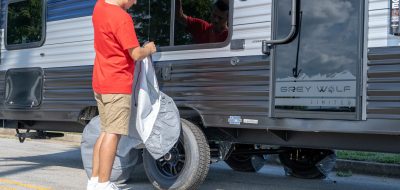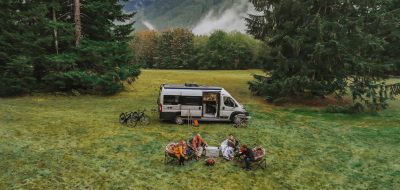 This is the second installment of our four-year-long cross-country trek on Historic U.S. Highway 80. The first installment covered the old route from San Diego, California to Yuma, Arizona. In this installment, our trip continues east into Texas.
This is the second installment of our four-year-long cross-country trek on Historic U.S. Highway 80. The first installment covered the old route from San Diego, California to Yuma, Arizona. In this installment, our trip continues east into Texas.
As we begin this second leg of our eastward sojourn along the path of old U.S. 80, the former coast-to-coast highway once touted as the “shortest and straightest road across the country,” we are still following a cobbled-together path of interstate highways and state, county and interstate-access roads. As we mentioned last issue, the original highway was decommissioned in stages between San Diego and Dallas years ago.
As you leave Yuma, proceed east on 32nd Street (Old U.S. 80) to Interstate 8. Follow the new road over steep Telegraph Pass, elevation 767 feet, where views are dramatic and sheer rock faces are a study in pastels-pink, lavender and fawn.
Desert and Dates
Leave the interstate at Wellton and continue east on Los Angeles Avenue (Old U.S. 80) to Mohawk then rejoin 1-8 and continue through the Mohawk Mountains, bald jagged peaks that sprout from a thirsty land of sage, creosote bush and other scant desert flora, to Dateland. There you can drive a stretch of Old 80 that passes orchards of the town’s namesake–date palms-and scattered ruins of adobe dwellings.
Return to the interstate and continue to Gila Bend. Take Arizona Highway 85 to Old Highway 80 toward Phoenix. This earliest version of U.S. 80 parallels Arizona Highway 8S and runs through a canyon of red and white striped bluffs that resemble an antique walled city high over this lonely landscape.
Just south of Gillespie Dam near the tiny burg of Arlington, you’ll cross the Gila River on Gillespie Bridge, an erector set-like “truss” bridge. The dam, a simple spill-over, was built by a local rancher in 1921. Soon after, the Arizona Highway Department poured a concrete apron at the foot of it for vehicles to cross, but when the Gila flooded the apron was impassable. The steel truss bridge built in 1927-at the time the longest highway bridge in Arizona-solved the problem. It was immediately incorporated into Highway 80 and carried cross-country traffic until1956, when the new road, today’s Arizona Highway 85, opened. During a flood in January 1993, the old dam failed and a 120-foot length of it collapsed into the river; remnants can still be seen. Gas lines were unearthed and ruptured, but amazingly the bridge survived.
Fun In Phoenix
Proceed along Old 80 to its junction with Arizona 85 near Buckeye, and North to Interstate 10 west of Phoenix. The historic route follows 1-10 east into the city, runs concurrently with U.S. Highway 60 (Superstition Freeway) and continues east on Highway 60 where the two roads split. Highway 60 will take you on to Florence Junction-but first enjoy some of Phoenix’ offerings, which in this metro area of 2000 square miles and more than 3.6 million residents, are many.
Among these are the Arizona Museum of Natural History; Commemorative Air Force Aviation Museum; Boyce Thompson Southwestern Arboretum, a cactus lover’s dream come true located east of Aorence Junction on Highway 60; and Taliesin West, now a National Historic Landmark, once the home, studio and architectural campus of architect Frank Lloyd Wright.
Hollywood’s Old West
Once you leave Phoenix, drive south from Florence Junction on U.S. Highway 89. Antique Florence, with more than 150 buildings and sites on the National Historic Register, has been the setting for numerous Western films. Among the town’s attractions are Pinal County Historical Museum; Pinal County Courthouse; and McFarland Historical State Park, the original Pinal County Courthouse. Built in 1878, it later served as a hospital and medical center, and in 1974 became a historical museum with many fine displays.
Highly recommended is the ten-mile side trip from Aorence to Casa Grande Ruins National Monument. Take Arizona Highway 287 to the four-story ruins built-for reasons no one today knows-in the 14th century by Hohokam Indians. The “big house” was already abandoned and crumbling when it was “discovered” by Father Kino two centuries later. Excavations began in 1891, and Casa Grande was made a National Monument in 1918.
Return to Florence and continue south on Highway 89 to a small, dusty park where a stone pylon topped with a black rider-less horse memorializes old-time film star, Tom Mix. Late one October night in 1940, the Western movie hero, en route to Florence after a night of cards and drinking, crashed his Cord “Phaeton” in the wash here and died when a metal suitcase in the back seat struck him in the head.
Old 80 runs through a magnificent cactus world, bisecting forests of furry yellow chollas, stately saguaros, hook-spiked barrel cacti and others, and providing sublime views to purple mountains strung along the horizon to the east and west.
Tooling Through Tucson
Once you reach Tucson, Interstate 10 which will take you through town. But first enjoy some of Arizona’s second largest city’s offerings, such as Saguaro National Park, a saguaro showplace with more than 150 miles of hiking trails; Arizona-Sonora Desert Museum; 18th century Spanish Mission San Xavier del Bac; and Old Town Studios, where hundreds of Western movies and television shows have been filmed and “gunfights” are frequently re-enacted. The historic route is concurrent with 1-10 to Benson, then continues on Arizona Highway 80 into New Mexico. Before you reach Benson, take Arizona Highway 90 for a nine-mile side trip south to Kartchner Caverns State Park. The magnificent caverns, nearly as pristine as when they were discovered in 1974, opened for tours a decade ago. The caverns are adorned with some of the finest speleothems (cave formations) anywhere: soda straws, columns, draperies, stalactites, stalagmites, coral pipes, needle quartz and many others. The park also offers hiking trails, a hummingbird garden, nature programs and an RV campground. Return to 1-10 and proceed to Benson, founded as a stop on the Butterfield Stage route. Arizona Highway 80 (Old U.S. 80) runs through the open desert that is Cochise County. Ahead is Tombstone, a “town too tough to die” and a showcase of Arizona history. Vast quantities of silver have been plucked from the hills here, but Tombstone is best known for the October 1881 “Gunfight at the OK Corral” between the Earps and Doc Holliday and the renegade Clantons, an event-lasting only about one minute-that is re-enacted regularly.
Mining Country
Mountainous Bisbee, Cochise County seat, is another town that grew up around a plethora of copper, gold and silver mines. Once home to some of the world’s most productive copper mines, the town famous for its blue turquoise-is now an art colony with numerous galleries and shops. Ninety-minute tram tours of the old Queen Mine are available; dress warmly as the temperature is always 47 degrees F. The old road dips nearly to the Mexican border at Agua Prieta, then arcs north to mining town Douglas. Here several Hispanic-themed festivals are annual happenings: a Border Run in April; Cinco de Mayo in May; Mexican Independence in September; and Two Flags International Festival in October. Old 80 proceeds north, crosses into New Mexico at Rodeo, rejoins 1-10 at Road Forks, and angles up to Lordsburg, a railroad town begun in 1880. Lordsburg-Hidalgo County Museum, with local history exhibits and recreation of the P.O.W. camp built for German and Italian prisoners during World War II, is worth a visit, as is Shakespeare Ghost Town, two miles south of Lordsburg.
Originally a small settlement on the Butterfield line, Shakespeare swelled after a silver strike in 1870 to a town of 3000. It dwindled after the 1893 depression, flourished again during the 1908-1932 mining boom, but was always considered unruly. Oddly, Shakespeare never had a church, newspaper or local law, but nonetheless played an important role in settling this part of the country.
Today the interstate in New Mexico follows most of Highway 80’s alignment, but at Deming, 58 miles ahead, take a short detour on Motel Drive (the old road) before returning to 1-10 and proceeding to Rockhound State Park east of town. You may legally collect up to 15 pounds of gemstones and minerals, and/or camp at the RV park.
Lovely Las Cruces
Las Cruces is the southernmost New Mexico town along the old Camino Real, or “Royal Road” that for 300 years was the route into New Mexico from Mexico City. Wind through town onto Avenida de Mesilla, which takes you to historic Mesilla, a charming town with a wealth of shops, art galleries, fine restaurants and Billy the Kid lore.
Unfortunately, much of old Las Cruces was destroyed to build the interstate. But the town, New Mexico’s second largest, has a fine Museum of Natural History and is distinguished as home to the nation’s only ‘chile’ institute. Vast fields outside Mesilla grow the colorful crop.
Border Towns
Take New Mexico Highway 478 and proceed south across the border into Texas, where the road becomes Texas Highway 20, paralleling the chocolate Rio Grande into El Paso, the largest U.S. city on the Mexican border-across from Juarez, the largest Mexican city on the U.S. border.
El Paso’s many attractions include a first-rate zoo; museums of art and history; Centennial Museum and Chihuahuan Desert Gardens; Fort Bliss, an Army post here since 1848; and San Jacinto Plaza, the original historic city. Tours of four early Spanish missions are available, as are sightseeing and shopping tours to Juarez.
Stay on Texas Highway 20 through the city to Interstate 10. Ten miles east of Kent the route turns northeast on Interstate 20 and continues to Abilene, which has a fine zoo and a 1612- acre state park that offers camping and more.
At Cisco take Texas Highway 6 (Old 80) for the ten-mile stretch to Eastland (where you return to 1-20), en route passing an open air collection of antique autos (Model A Ford, Model B Ford and more than a dozen others).
Heart of Texas
The historic route continues on Interstate 30 at Fort Worth, a city of 700,000 with numerous attractions. Among these are a museum of science and history; nature center and 3600-acre wildlife refuge; Log Cabin Village featuring authentic 1850’s log cabin homes; six-acre Japanese Garden; one of the country’s top zoos, with a world-famous reptile collection; Kimball Art Museum; largest Civil War museum west of the Mississippi; Texas Motor Speedway and much more.
Cosmopolitan Dallas is just ahead. This city of 1.2 million, which began as a single log cabin 169 years ago, has since become a mecca for shoppers, culture enthusiasts and sports fans, plus some three million visitors who come for the annual State Fair. And there’s more, much more-but it must wait. Now it’s time to find a campground.
By Pam Selbert




